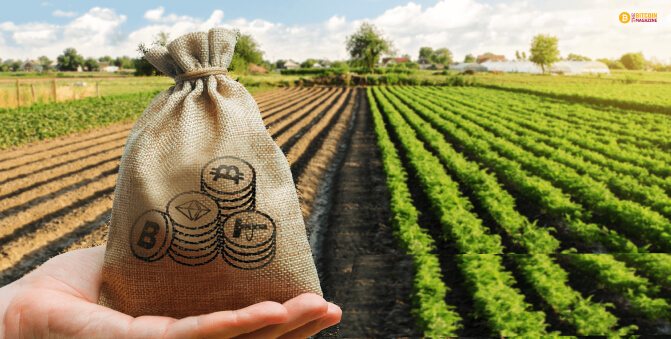Yield farming happens to be a potentially lucrative method of earning revenue in the DeFi industry. But it comes with plenty of risks.
Inspite of the risks, it’s one of the most well-known revenue-generating methods in DEFi markets across the globe, allowing users to earn above-average revenue potentially by simply depositing cryptocurrencies in the yield-farming protocols.
Keep reading to find out more about the concept of yield farming and how it actually works.
So, What Is Yield Farming?

Yield Farming is a method by which you can deposit crypto tokens into any liquidity pool on a decentralized finance protocol for earning rewards, commonly paid out in the governance token of the protocol.
Investopedia defined yield farming as “Yield farming is a high-risk, volatile investment strategy that involves investors staking, or lending, cryptocurrency assets on a decentralized finance (DeFi) platform to earn a higher return. An investor may receive payment on the return in additional cryptocurrency. Yield farming took off in popularity due to its applications, such as in liquidity mining, which is the practice of lending crypto assets to a decentralized exchange in return for incentives. Yield farming was once the largest growth driver of the fledgling DeFi sector, but has lost most of its 2020 hype after the collapse of the TerraUSD stablecoin in May 2022.”
There are various ways in which you can yield farm. However, the most typical methods included depositing cryptocurrency assets in either a trading pool or a decentralized lending pool for providing liquidity.
LPs or liquidity providers earn a particular percentage yield or APY in exchange for offering liquidity to certain platforms. Now, this is typically paid out in real-time.
DeFi or Decentralized Finance projects allow yield farming to encourage the utilization of their platforms, rewarding their entire community towards contributing liquidity. And that happens to be the lifeline for a majority of DeFi platforms.
Brief History Of Yield Farming:
In the month of June back in 2020, Compound, a credit market based upon Ethereum, started passing out an ERC-20 asset known as COMP, known for permitting Compound protocol’s community governance to the users of the protocol.
This type of asset is known as a governance token. It provides holders with voting rights, which in turn offers them some power over changes on the platform. General interest in this token acted like a catalyst, making it popular and moving Compound towards a leading spot in the world of DeFi. Soon after that, ‘yield farming’ emerged as a term.
How Does the Concept Of Yield Farming Work?

While the process of how yield farming works can differ from protocol to protocol, generally, it includes liquidity providers or LPs. These LPs are also known as yield farmers. Yield farmers deposit the token in a decentralized finance app, earning rewards in exchange. These farmers earn the rewards in real-time and in the specific token of the protocol.
The rewards of yield farming are actually represented as APY. Also, these tokens are basically locked within smart contracts that reward users programmatically with tokens while they fulfill particular conditions.
Commonly, the process of yield farming works through the following steps:
- Select any yield farming protocol. For instance, you can opt for an AMM (Automated Market Maker) such as PancakeSwap.
- Once you are on the platform known for decentralized trading, tap on the ‘Liquidity’ button for accessing the section meant for LPs.
- Then, you will have to select the assets you want to deposit in any liquidity pool. For instance, you want to deposit CAKE and BNB in the CAKE/BNB pool.
- Once you are depositing two assets in a trading pool, you will obtain an LP token.
- Then, just take the token, navigate to the ‘Farms’ section, and deposit the same in the CAKE/BNB yield farm for earning your rewards, apart from the transaction fees that you will get as your percentage of the liquidity pool.
A majority of decentralized finance protocols typically reward governance tokens to farmers. These, in turn, can be utilized for voting on decisions associated with that particular platform and can be traded as well on exchanges.
Yield Farming: Benefits And Risks

Yield farming provides individuals with a space to earn income from a passive source. However, the potential high returns come with a substantial amount of risk. So, let’s look at the benefits as well as the risks associated with the concept of yield farming.
The Benefits Of Yield Farming:
The top benefits of yield farming are as follows:
1. High Yields:
Some decentralized finance projects provide lucrative yields. These yields are so attractive that they exceed conventional financial instruments. Depending on the different market conditions, users can earn potentially substantial yields on their capital.
2. Liquidity Provision:
Yield farming allows effective trading, reducing any kind of slippage on the DEXs. By offering liquidity, you can play a vital role in the DeFi ecosystem’s functioning.
3. Passive Income:
Instead of just holding, you can also put your holdings for working and earning rewards. And that, too, you can do in the form of extra tokens as well as transaction fees without actively trading.
The Risks Of Yield Farming:

The biggest risks of yield farming are as follows:
1. Impermanent Loss:
Impermanent loss typically takes place in automated market makers. This takes place due to the mechanism needed for maintaining balanced liquidity situated between the pool’s tokens.
If the costs of the pool’s token change significantly once you have provided liquidity, the automated system of the platform might end up rebalancing the pool by buying relatively cheaper tokens and selling the ones that are more costly. The rebalancing can often lead to a loss for the yield farmers.
2. Smart Contract Flaws:
Decentralized finance protocols are developed on smart contracts. Hackers can easily exploit any vulnerabilities or bugs in the code, leading to the loss of deposited funds.
3. Fluctuating Rates:
Yields transform depending on demand and supply dynamics, which makes it difficult to predict the potential yields in the future. For instance, rewards can collapse once more individuals supply assets.
4. Volatile Prices:
Crypto prices can be very volatile, impacting the worth of rewards as well as the assets users have deposited. In case the token a user is earning, their rewards significantly drops in value, then all their revenue will get eroded away.
Wrapping Up: Is Yield Farming Worth It?
While the concept of yield farming is a lucrative method of earning yields in the crypto space, it also happens to be a risky activity. Even if you do yield farming on any trustworthy DeFi protocol, you can experience a loss of funds thanks to hacks and risks associated with smart contracts.
Moreover, a user’s potential profits from yield farming highly depend on the costs of the protocol token they obtain as their reward. In case the protocol token’s value falls, then their returns will also dwindle easily.
Finally, the return that a user receives at present might not be the return they will get in the near future. High returns tend to compress as more yield farmers begin to move around funds into a high-return farm, affecting a user’s returns.
If you are able to handle the risk, then this can be a fun way to earn passive income on your cryptocurrency. But you should definitely do your share of the research and choose not to invest any more than you are fine with losing.
Additional Reading:

